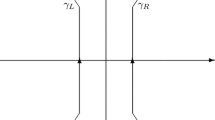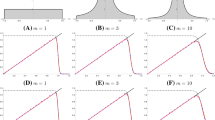Abstract
We present a random matrix ensemble where real, positive semi-definite matrix elements, x, are log-normal distributed, exp[−log2(x)]. We show that the level density varies with energy, E, as 2/(1+E) for large E, in the unitary family, consistent with the expectation for disordered conductors. The two-level correlation function is studied for the unitary family and found to be largely of the universal form despite the fact that the level density has a non-compact support. The results are based on the method of orthogonal polynomials (the Stieltjes-Wigert polynomials here). An interesting random walk problem associated with the joint probability distribution of the ensuing ensemble is discussed and its connection with level dynamics is brought out. It is further proved that Dyson’s Coulomb gas analogy breaks down whenever the confining potential is given by a transcendental function for which there exist orthogonal polynomials.
Similar content being viewed by others
References
M L Mehta, Random matrices (Academic Press, New York, 1991)
G Montambaux, in Quantum fluctuations Les Houches, Session LXIII edited by E Giacobino, S Reynaud and J Zinn-Justin (Elsevier, Netherlands, 1995)
Y Imry, in Directions in condensed matter physics (World Scientific, Singapore, 1992)
Two-dimensional quantum gravity and random surfaces edited by D J Gross, T Piran and S Weinberg (World Scientific, Singapore, 1992)
S W McDonald, Ph.D. Thesis (UMI-8413506, Ann Arbor, MI, 1983)
O Bohigas, M-J Giannoni and C Schmit, Phys. Rev. Lett. 52, 1 (1984)
S R Jain and S V Lawande, Proc. Indian Natl. Sci. Acad. 65, 275 (1995)
S Washburn and R A Webb, Adv. Phys. 35, 375 (1986)
T H Seligman and H Nishioka, Quantum chaos and statistical nuclear physics, Lecture notes in Physics (Springer, Heidelberg, 1986) vol. 263
K A Muttalib, Phys. Rev. Lett. 65, 745 (1990)
P A Lee and T V Ramakrishnan, Rev. Mod. Phys. 57, 287 (1985)
R Landauer, IBM J. Res. Develop. 1, 233 (1957); Philos. Mag. 21, 863 (1970)
P W Anderson, D J Thouless, E. Abrahams, and D S Fisher, Phys. Rev. B22, 3519 (1981)
V I Mel’nikov, Sov. Phys. Solid State 23, 444 (1981)
K A Muttalib, Y Chen, M E H Ismail and V N Nicopoulos, Phys. Rev. Lett. 71, 471 (1993)
Y Chen, M E H Ismail and K A Muttalib, J. Phys. C5, 177 (1993)
F J Dyson, J. Math. Phys. 13, 90 (1972)
P Pechukas, Phys. Rev. Lett. 51, 943 (1983)
T Yukawa, Phys. Rev. Lett. 54, 1883 (1985)
S R Jain and Z Ahmed, Brownian motion model of random matrices revisited (preprint) 1999
A Erdelyi, W Magnus, F Oberhetinger and F G Tricomi (eds), Tables of integral transforms Bateman manuscript project (McGraw-Hill Inc., New York, 1954) vol. 2, p. 244
G Szegö, Orthogonal polynomials, AMS Colloquium Publications (AMS, Providence, Rhode Island, 1939) vol. XXIII
Appendix 6 in ref. [1]
P Forrester, J. Stat. Phys. 76, 331 (1994)
B V Bronk, J. Math. Phys. 6, 228 (1965)
The coefficients are a=0.063, b=−1.690, c=12.279, d=−22.123, c=12.003, f=−5.912, g=13.020, h=−8.111, i=−5.677, j=6.068
M Kreynin and B Shapiro, Phys. Rev. Lett. 74, 4122 (1995)
T Nagao and K Slevin, J. Math. Phys. 34, 2075; 2317 (1993)
E. Brezin and A Zee, Nucl. Phys. B402, 613 (1993)
J Ambjorn, J Jurkiewicz and Yu M Makeenko, Phys. Lett. B251, 517 (1990)
G Hackenbroich and H A Weidernmüller, Phys. Rev. Lett. 74, 4118 (1995)
C Blecken, Y Chen and K A Muttalib, J. Phys. A27, L563 (1994)
Author information
Authors and Affiliations
Rights and permissions
About this article
Cite this article
Ahmed, Z., Jain, S.R. Random matrix model for disordered conductors. Pramana - J Phys 54, 413–422 (2000). https://doi.org/10.1007/s12043-000-0133-y
Received:
Revised:
Issue Date:
DOI: https://doi.org/10.1007/s12043-000-0133-y




